Summary
English Learner (EL) students in California’s schools are numerous and diverse, and they lag behind their native-English-speaking peers. Closing the achievement gap for EL students has been a long-standing goal for California educators, and there are some signs of success. Now that EL funding and curriculum issues are receiving a fresh level of scrutiny from decision-makers in Sacramento, it is important to assess our understanding of this diverse group, highlight the opportunities to improve policies around demonstrating mastery of English, calibrate funding formulas involving EL students, and implement new curriculum standards thoughtfully.
Introduction
Nearly 25 percent (or 1.4 million) of the students in California’s public schools are English Learners. Because many students transition out of EL status, the percentage of students who have ever been designated as EL is greater still.
Test scores suggest that California’s schools have had some notable successes in educating certain ELs. For this reason, educators, policymakers, and the general public have long been concerned with designing policies that help ELs transition quickly into academic instruction without support.1 Long-term ELs do have poor academic outcomes; furthermore, there is some indication that students who transition out of EL status can struggle in later grades.
Improving long-term academic outcomes for current and former ELs will help a greater proportion of California’s youth prepare for higher education and the labor force, ending the intergenerational transmission of low educational attainment and socioeconomic status. Given the recent uptick in attention to EL policy at the state level, it is especially important to understand who EL students are, what challenges they face, and how we can refine our policies and practices to help them succeed.2
Who and Where Are California’s English Learner Students?
Statewide policy determines which students are initially classified as ELs, but the determination of current versus former ELs (as well as the type of EL instruction) varies across school districts.3 Most ELs start in California schools as kindergartners.4 Parents who enroll their children are asked whether a language other than English is spoken at home. If the answer is yes, their children take the California English Language Development Test (CELDT), A key component of the diversity of ELs is their ever-changing nature.which assesses listening, speaking, reading, and writing in English at all grade levels. Students who score below “early advanced” are classified as ELs.5 In 2010-2011, 9 percent of kindergartners tested scored “early advanced” or above.6
EL Students Are a Diverse Group
A key component of the diversity of ELs is their ever-changing nature, which is difficult to document with the existing snapshots available from statewide data. The group of students classified as ELs is not static’successful ELs exit the population as they are reclassified, less successful ELs remain, and new ELs are added at every grade level as new students enter from abroad, or from other states or schools.
Despite this diversity, we can identify some common EL characteristics. The vast majority (85%) of California’s EL students speak Spanish at home, but there are at least 59 other languages spoken in California’s schools (Figure 1). After Spanish, the next most common languages are Vietnamese (3%) and Filipino (1%). An important reason for policymakers to focus on ELs is that their poverty rates range from 74 to 85 percent, much higher than the 21 percent overall poverty rate for California school-aged children.7
Figure 1. Most of California’s EL Students Speak Spanish at Home
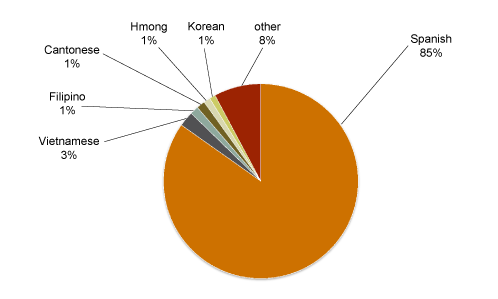
SOURCE: CDE Language Census, 2009-2010.
The majority of California’s ELs are native-born-but, not surprisingly, a large share of older EL students are foreign-born. National estimates reveal that 82 percent of current EL students in grades K-5 are native-born, but this percentage drops to 55 percent in grades 6-12.8
More than 180,000 (or 13%) of California ELs are kindergartners (Figure 2). The number of ELs drops in higher grades as some EL students become proficient enough in English to be reclassified, drop out of school, or move away from California.
Generally speaking, ELs cannot be reclassified until they reach the second grade. Data suggest that most reclassification occurs in grades 3-5.9 By the high school grades, the majority of students who have ever been ELs are reclassified as proficient in English (the official term is Reclassified Fluent English Proficient, or RFEP).
The majority of California’s ELs are native-born-but, not surprisingly, a large share of older EL students are foreign-born.
Students who remain ELs for five or more years are commonly called Long Term English Learners, and they make up the majority of ELs in secondary school.10
ELs attend schools in districts throughout the state, but are concentrated in larger districts: 17 percent are in San Diego Unified and Los Angeles Unified alone.11 Most ELs live in urban areas, as does the state’s population. They also attend schools in some rural areas in large (and disproportionate) numbers, such as Imperial and Monterey Counties, where 43 percent and 39 percent of students are ELs (the state average is 23%; Figure 3). Other counties in which ELs are overrepresented include Colusa, Mono, and Santa Barbara.
Figure 2. English Learners and Reclassified Fluent English Proficient Students by Grade
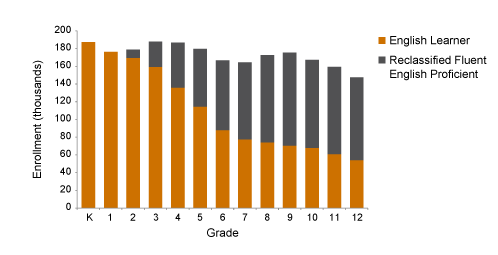
NOTES: We use the number of EL and RFEP CST-takers for our counts for grades 1-11. This is the only available source for counts of RFEPs in state data, and EL counts do not match those from CALPADs exactly. For kindergarten, we use the number of initial CELDT takers who did not meet the IFEP threshold, which likely overcounts them somewhat, especially when compared to the number of EL kindergartners from CALPADs in 2010-2011, which is missing grade and language detail for 415 districts, including LAUSD. CST results are not available for 12th grade. RFEPs are estimated from grade 11 RFEP test takers in the previous year. R. Linquanti (“Strengthening Assessments for English Learner Success,” PACE Seminar for Education Policymakers and Scholars, November 18, 2011) uses a slightly different method.
Figure 3. There are Large Numbers of EL Students in Many California Counties
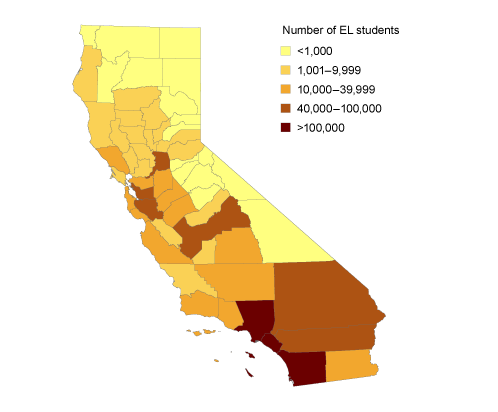
SOURCE: CDE enrollment data, 2010-2011.
Academic Outcomes Vary
Scores on standardized tests have been rising for all students over the past nine years. However, ELs score substantially lower on the California Standards Test (CST) than other groups of students. Students who have transitioned out of EL status are the most likely to achieve scores of Basic or above in English Language Arts (ELA) on the CST (Figure 4).12 In fact, former ELs perform better than both English Only and English Learner students.13
Figure 4. EL Students are Less Likely to Score Basic and Above on the English Language Arts California Standards Test
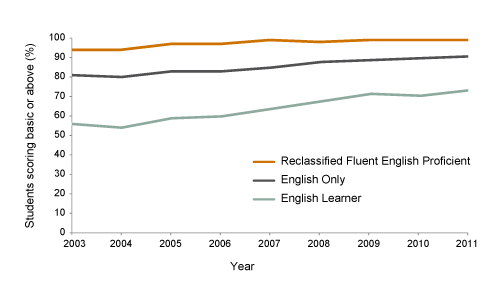
SOURCE: CDE CST scores, grade 4.
Former EL students also pass the California High School Exit Exam (CAHSEE) at high rates, while ELs have low rates of passage (Table 1). In 2011, 94 percent of former ELs passed the ELA portion of the grade-10 CAHSEE, as did 87 percent of English Only students.14 EL passage rates were only 44 percent. Math and ELA passage rates were similar for all groups except ELs, who passed math at substantially higher rates than they did ELA: 56 versus 44 percent.15
Table 1. Reclassified Students Pass the CAHSEE at High Rates

SOURCE: CDE CAHSEE results for grade 10, 2010-2011.
This seems to suggest that being reclassified as English proficient is associated with stronger academic performance. However, there is some evidence that not all former ELs remain strong performers over time. When we examine the share of students who score “proficient or above” on the ELA CST for every grade, we find that RFEPs are more likely to be proficient than the other language groups through 5th grade (Figure 5).16 But by the 7th grade, reclassified students score below English Only students. And when they take the ELA CST in the 11th grade, only 47 percent of former ELs score proficient or above, as compared to 90 percent in the 4th grade. In contrast, the passage rate for English Only students declines from 72 percent in 4th grade to 52 percent in 11th grade.17 Since we are not able to follow individual students’ educational trajectories, we cannot see if the lower scores at older grades result from an erosion of skill for individual students or if students reclassified at later grades generally score worse and are diluting the pool of high scores as the grades progress.
Figure 5. Until Grade 7, Reclassifed Students are More Likely to Achieve CST Scores of Proficient or Above
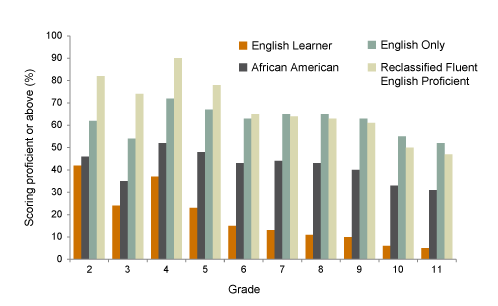
SOURCE: CDE CST Scores, 2010-2011.
How Can We Help?
Recent developments on the EL policy front have the potential to affect our success with English Learners. In recent months, Senator Alex Padilla formed a select committee on ELs, and California’s Department of Education created an EL Support Division. The governor’s 2012-2013 education budget proposal included a student-weighted formula that would have increased funding for ELs. While it was not implemented, it seems likely that some version of the weighted student formula will resurface in the coming months.
These developments signal an increase in attention to EL issues and underline the need to approach them thoughtfully. We touch on three of these issues below: reclassification policy, the implementation of Common Core State Standards, and the question of funding and accountability.
Reclassification
Because reclassified students generally fare much better on academic outcomes than ELs, some state policymakers urge that ELs be reclassified as quickly as possible. However, it is not always easy to determine when a student would no longer benefit from EL support.18 Also, the push for reclassification presumes that ELs are held back by their status-that after a certain point EL instruction no longer benefits them and/or that their status precludes access to appropriate academic classes. Yet we see evidence that not all former ELs achieve at high levels after reclassification, and reclassification does not always increase access to appropriate or advanced academic content.19
We need to understand the associations between reclassification policies and academic outcomes, and analyses of longitudinal student level data across a variety of California school districts is the way to learn what policymakers need to know. In addition, when it comes to redesigning reclassification policies, policymakers need to weigh the potential benefits (or drawbacks) of additional EL instruction against longer-term monitoring and support for former ELs.20 The design of the ideal reclassification policy is also complicated both by the incentives created by federal and state funding, and by the implementation of new curriculum and assessment standards for all students in 2014, which we discuss below.
Common Core State Standards
Like most other states, California is in the middle of implementing new Common Core State Standards (CCSS) throughout its K-12 curriculum and designing ways to assess students’ mastery of the new standards. The new curriculum raises the bar for the use of complex English in all academic subjects. This is expected to pose particular challenges for EL students, who are already struggling to learn basic English.21 Researchers and educators are endeavoring to make the assessments meaningful for all students, but there is concern that not enough attention will be paid to the additional challenges ELs will face.22 This concern could be addressed by the planned revision of standards for English Language Development to align them with CCSS standards-which may provide an opportunity to link EL instruction and regular course instruction more closely.23
Funding and Accountability
There is broad agreement that it costs more to provide adequate education to EL than to English Only students, but there is less clarity about how much in additional funding is required.24 Currently, both the federal and state government provide extra funding to districts based on the numbers of ELs attending district schools.25 They do not provide extra funding for former ELs.26 Funding EL students at higher levels than non-EL students can create disincentives for reclassification. And given the likelihood that some former ELs could benefit from additional monitoring and support, additional financial support for these students could lead to better outcomes and remove financial disincentives for reclassification.
The federal funding for ELs comes with accountability requirements.27 State funding for supplemental services to ELs is not predicated on meeting annual accountability targets. Indeed, some policymakers are concerned that dollars may not always reach targeted schools and students or be spent effectively if they do. These concerns were not allayed by the governor’s 2012 proposal to increase funding for EL students, which did not stipulate how these funds should be spent.28 Improving the efficiency of our EL spending requires a clear understanding of how EL dollars are spent within districts and schools, and then linking spending to outcomes. For these purposes, it would be helpful to have the ability to use longitudinal student level data to monitor the progress of ELs and RFEPs over time.
Where do we go from here?
We have highlighted some of the important ways in which the EL population is diverse and challenging to educate: age at entry, nativity, poverty, languages spoken, and dispersal throughout the state.
As measured by test scores, California’s schools have had some notable successes in educating ELs. Still, there are important concerns. Currently, decisionmakers are grappling with critical policy issues regarding reclassification, funding and accountability, and implementing new curriculum and language development standards, all of which could improve outcomes for ELs. Additional research using district-level data will add substantially to our understanding of reclassification and student success, and will make policymakers aware of potential trade-offs involved in lowering the reclassification bar. The development of Common Core Standards can be an opportunity to link academic and EL instruction. In addition, it will be critical to create effective incentives for districts to direct supplementary state funding for ELs to ELs and potentially to recently reclassified ELs. Finally, the development of Common Core Standards can be an opportunity to link academic and EL instruction-and perhaps even lower the academic stakes of reclassification.
Policymakers need to consider the impact their decisions will have on EL students’ long-term success. Because so many of California’s current and future students have had, or will have, EL status at some point during their childhoods, graduating more and better prepared EL and former ELs is an issue of tremendous importance for California’s future.
Topics
K–12 Education Population

